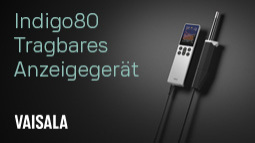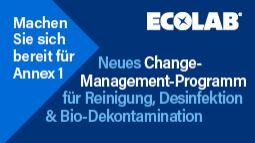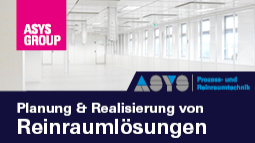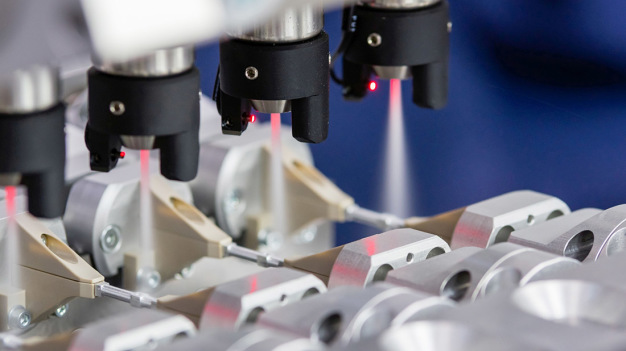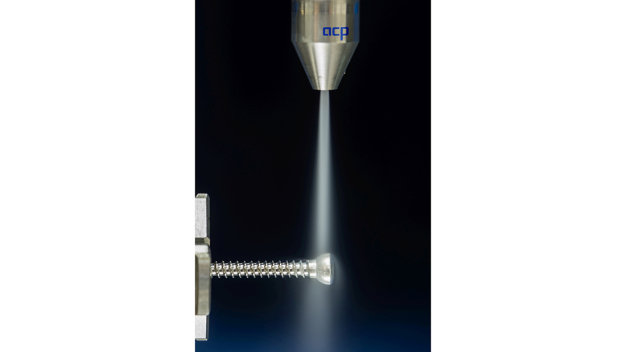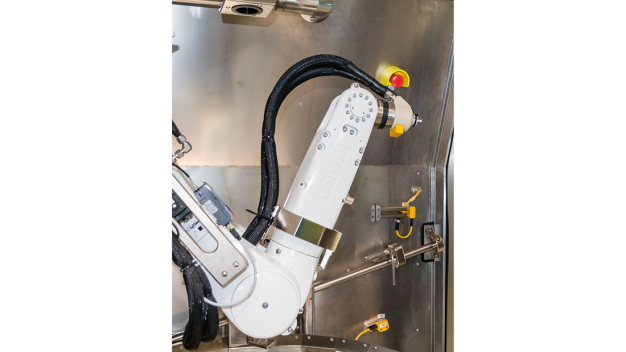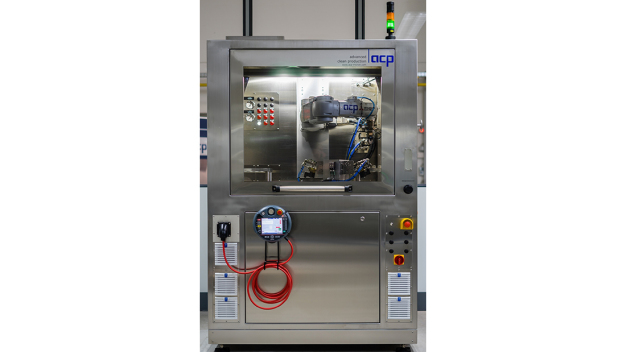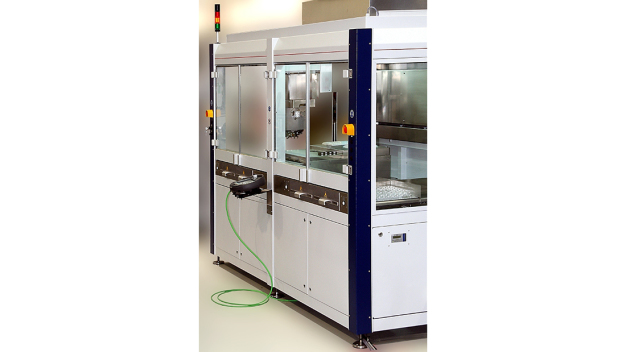- Planning
Cleaning with CO2 snow in cleanrooms using a dry and residue-free process
Parts cleaning is indispensable in the manufacturing industry to ensure high quality standards and cleaning processes are increasingly being carried out in clean environments. As far as the technique, design, process reliability and automation are concerned, the proven quattroClean technology offers many advantages.
Whether it’s the automotive and supplier industry, optics, medical engineering, semiconductor industry or microtechnology – cleaning processes are key technologies that guarantee the quality and function of products in numerous industrial sectors. Cleanliness requirements vary depending on the product, the manufacturing phase and the following step in the production chain, such as coating, bonding, assembly or packaging. There is a growing demand for cleaning processes that are suitable for use in clean environments or cleanrooms.
The modular quattroClean snow jet technology from acp systems AG has proven to be an efficient, reliable and cost-effective cleaning process. It is therefore being implemented more and more to replace conventional methods such as wet chemical cleaning. The reasons for this include its compact dimensions and lower investment and operating costs.
Four effects for clean, residue-free surfaces
The cleaning medium used for the process is liquid non-corrosive carbon dioxide which has a practically unlimited shelf life. It is created as a by-product of chemical manufacturing processes and biogas energy generation, thus making it environmentally neutral.
The heart of the cleaning system is a wear-free two-component ring nozzle, through which the non-flammable and non-toxic carbon dioxide is fed. On exiting the nozzle, the carbon dioxide expands to form fine CO2 snow, which is then bundled by a separate circular jacketed jet of compressed air and accelerated to supersonic speed.
When the easily-focused jet of snow and compressed air impacts on the surface to be cleaned at a temperature of minus 78.5°C, a combination of thermal, mechanical, sublimation and solvent effects occur. The combined effect of these four mechanisms removes particulate and filmic contamination such as microchips, dust, abrasion, processing media residues, polishing pastes, separating agents, silicones, fluxes and smoke residues in a reliable and reproducible way.
During the cleaning step, the crystalline carbon dioxide is transformed from a solid to a gaseous state, with the result that the cleaned material dries instantly. Detached impurities are removed from the component surface by the aerodynamic force of the compressed air and transported away together with the sublimated carbon dioxide by an extraction unit integrated into the cleaning module. The cleaning process is so gentle on materials that it can even be used to clean delicate and finely-structured surfaces. The dry cleaning process is suitable for workpieces made from practically all technical materials and material combinations.
Full-surface or partial cleaning with uniform results
The quattroClean system is scalable and can therefore be easily and space-savingly adapted to different component geometries for partial or full-surface cleaning. Depending on the task, one or more single nozzles or a nozzle array are used. The patented technology ensures uniform cleaning results even where large surfaces are concerned.
Through pilot tests in the acp systems technical center, all process parameters, such as the volume flows for compressed air and carbon dioxide as well as the length of time and area the jet is applied to, are precisely tailored to the respective application. The parameters take not only material properties into account but also the type of contamination requiring removal. If desired, they can be filed as part-specific cleaning programs in the system controls.
To ensure a consistently high process quality, the supply of CO2 and compressed air to the nozzles and the consistency and duration of the jet can be individually monitored and the values recorded automatically stored. The concentration of CO2 around the inlet and outlet of the plant adjacent to the production environment can also be monitored with internationally-certified sensors.
Systems for manual, semi-automated and fully-automated cleaning
The criteria determining the design of the systems are the cleanliness and cycle times required. Based on these specifications, acp systems uses standard modules to develop customized manual, partially and fully automated plant concepts - both as stand-alone solutions as well as ones for integration into production lines and networked manufacturing environments. The latter is made possible by the system's industry 4.0 capability. Thanks to standardized interfaces, it is no problem to integrate the systems into higher-level master computers and to control them via these. To ensure complete documentation and traceability, all process parameters are automatically recorded, stored and transferred to the host computer.
Different concepts for cleanroom-compatible design
When production takes place under clean conditions, during the cleaning process it is essential that no contamination from the surroundings reaches the product or is released into the environment, and that recontamination of the product is reliably avoided. To meet these requirements, a corresponding system for preparing the liquid carbon dioxide and compressed air is integrated into the plant. The air supply, extraction system and other features, such as components for automation and pick & place, are adapted to the respective cleanroom class. The design of the cleaning module also focuses on creating optimum airflow conditions in order to ensure fast and reliable removal of detached contamination. Different solutions are used to tailor the cleaning system to customer requirements and the space available.
The cost-effective solution: clean machine concept
For applications where only the cleaning process needs to be performed under clean conditions, the so-called “clean machine” concept is ideal. These systems are equipped with an encapsulation with integrated clean air supply. Positive pressure prevailing inside the cleaning module prevents contaminated air from entering from the environment. Since these systems are made from electropolished stainless steel, the interior surfaces are exceptionally smooth and easy to clean.
A sensor manufacturer uses this solution, for example, to clean particles off sensitive sensors before packaging. The sensors are fed into the system by a drawer unit designed according to the poka yoke principle, with trays containing soiled sensors arranged in a specific way. As soon as the drawer is in position, a specially-designed holder mounted on a linear unit takes two sensors and transports them to the cleaning unit, where they are picked up by a special gripping mechanism. Two nozzles then blast a jet at a defined angle onto the sensors, which rotate during the cleaning process. Detached particles are removed immediately and effectively from the cleaning cell by an air extraction module. After cleaning, the gripper mechanism transfers the sensors back to the linear holder. The "dirty" and "clean" parts are kept strictly separate to prevent recontamination after cleaning. The sensors are placed on clean parts trays that are supplied via a second drawer system.
Cleanroom applications
Complete encapsulation is also available for systems that are integrated into a cleanroom. In this case, the clean air is supplied with negative pressure. Thus, air is sucked in from the cleanroom and removed via an extraction unit integrated in the cleaning module. This prevents particles or other forms of contamination from reaching the cleanroom environment.
This solution is used, for example, by a medical device manufacturer to clean stents. One of the challenges here was to optimize the cleaning process to the requirements of the extremely delicate components. On the one hand, the stent has to be held securely in place during cleaning. On the other hand, it may not be deformed and all adhering particles and filmic residues must be reliably removed. To achieve this, a special parts holder was developed that is fed to the cleaning jet by a robot.
A manufacturer of lithography systems for the semiconductor industry placed extremely high demands on the cleanroom-compatible design of the cleaning system. Among other things, these were met by equipping the media preparation system for the compressed air and liquid carbon dioxide with special filtration systems that guarantee a particle- and hydrocarbon-free media supply. The extraction unit for the removed contamination and sublimated CO2 is designed as a three-step filter system.
The plant integrated into the cleanroom is used to clean optical components for EUV (extremely ultraviolet radiation) lithography, which are heavily contaminated with adhering impurities and smoke residues. A nozzle is utilized for cleaning, which is moved over the surface to be cleaned by a robot according to a specific motion sequence and at a precisely-defined distance. Compared to the wet chemical process previously used, the cleaning time could be significantly reduced and neither chemicals nor water are required. Furthermore, the cleaning process is gentler and produces better results.
![]()
acp systems AG
Berblingerstraße 8
71254 Ditzingen
Germany
Phone: +49 7156 480140
email: mail@acp-systems.com
Internet: http://acp-systems.com
